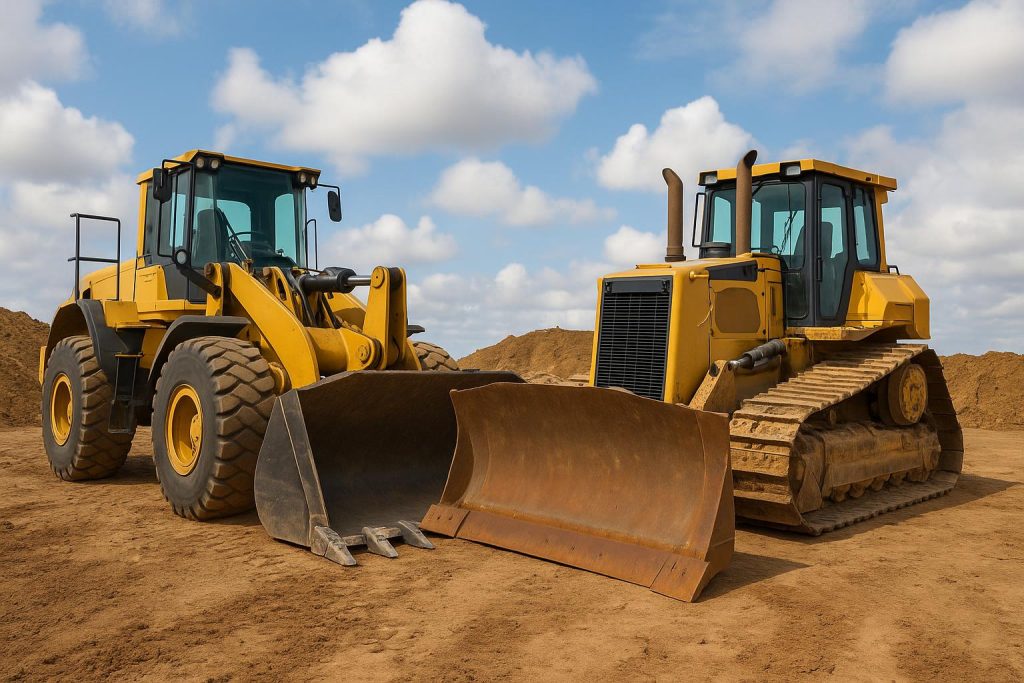When you’re on site, looking out over piles of dirt that need to be displaced or materials that need relocated, the choice of loader equipment is at times a cost-balancing and technological act. Every constructor understands that a poorly selected machine means squandered fuel, dormant manpower, and missed deadlines. With so many differing types of earthmoving equipment out there, what do you do to find out what tool is most suited for the job? We deconstruct three of the most often compared machines, the general-purpose loader, the highly versatile skid steer, and the bruiser bulldozer- and explore the ways the industry procures and uses them in practical conditions.
Contents
Loaders The Construction All-Rounders
Wheel and tracked loaders are at times referred to as the Swiss Army knife of mid-size and large-scale earthmoving. Material handling is their primary function, that is to say, to load dirt, aggregates, demolition debris, or feed stock into trucks or hoppers.
Industry Practices
In practice, project managers perceive the loader as a midlife fleet asset. They buy them from dealership financing and from OEM leasing packages. In quarries and mines, the loader is kept for between 15,000–20,000 work hours, while in the usual building sites, corporations rotate it earlier with the intention of lessening the chance of downtime.
How to Choose
- Site size: Largest sites, open sites.
- Material Density: Wheel loaders excel in loose aggregates, while tracked loaders are better on wet ground or uneven terrain.
- Productivity measurements: Match bucket size with hauler capacity to avoid bottlenecking.
In human equivalents, a loader is as useful as the reliable midfielder in a football game, whenever you need them, covering the gap between heavy excavations and final haulage.
Skid Steer Loader- The Multi-Tasker With
In case loaders are all-rounders, then the skid steer loader is the versatile gymnastics- lightweight, versatile, and fast to get used to. It’s a regular fixture on small building sites, ground-scapes, and even city works where space is of essence.
Key Functions
- Attachment variety: Augers, trenchers, and breakers may be instantly attached with hydraulics.
- Maneuverability: Zero-radius turning gives it an advantage over crowded spaces.
- Precision work: Grading, trenching, and site work on restricted-access sites.
Skid steers are rented for a relatively short period until they are purchased in full. Contractors are eager to test out the combination of the hydraulic system with preferred attachments. In fact, the majority of acquiring specialists are of the opinion that the ROI of a skid steer is not in a base machine, but in an attachment system.
Industry Practices
Skid steers are regularly leased for a short while before being purchased outright. Why? Because contractors want to get familiar with interfacing hydraulics with desired attachments. In fact, most procurement folks think the ROI of a skid steer is not in the core machine, but rather in the attachment system.
Renters rotate the skid steers at between 4,000–6,000 hours, with their hydraulic efficiency maintained at optimal. Larger corporations always have telematics systems incorporated.
How to Choose
- Project size: Ideal for small to medium-sized projects.
- Access restrictions: Ideal where trailers or heavy machinery cannot gain access.
- Attachment requirements: Choose machines with higher flow hydraulics if heavy-duty attachments are part of the plan.
In layman’s terms, a skid steer is the young engineer-in-training of the site–they might not be as strong as a bulldozer but get 12 other light jobs done before lunch.
Bulldozer The Instrumental Machine
Then there is the bulldozer- a vehicle all about heavy pushing and not about gentleness. Bulldozers are the heavy-horses of large earthmoving, ideal for site clearance with an aggressive touch, heavy-duty grading, and reworking ground.
Key Functions
- Pushing capacity: Bulldozers are best for site clearance, overburden removal, and leveling large tracts.
- Blade control: New blades with modern GPS systems provide centimeter-level precision grading.
- Ripping: Rear-mounted rippers remove hardpan and hard rock to facilitate deeper digging.
Industry Practices
Bulldozers are rarely rented on jobs of short tenure because of their costly purchase price and haulage requirements. They are instead purchased through long-term OEM financing or accredited used equipment programs. Large civil contractors purchase and own them, expecting 20,000+ hours of usage, with extensive rebuilds in between.
Comfort for the operator and fuel efficiency have been foremost considerations over the past decade, with Komatsu and Caterpillar offering hybrid power plants and comfort cabs. Contractors are applying machine control systems with greater frequency as a means of reducing operator fatigue and gaining consistent gradations from shift to shift.
How To Choose
- Project type: Suitable for highways, mass site preparations, and mining.
- Terrain: Ideal for mountainous, undeveloped terrains
- Budget horizon: Seen as a generational investment—potentially handed down over multiple projects.
Consider the bulldozer as the heavy forward in a rugby game—it won’t dance, it won’t coddle, but where you need ground brought over, there is no substitute for brute power.
Wrapping It Up
Each machine, the loader, bull dozer, and skid steer, is individually valuable in the building and earthmoving system. Purchase initiatives are not about pursuing the biggest or newest machine, but about filling project demand with machine capacity.
Loaders are ideal for heavy-volume material handling for medium and large sites. Skid steers are best in numerous, small-footprint job sites where versatility is needed. Bulldozers rule brute-force jobs, wherein land clearance and re-sculpting are determiners of success.

